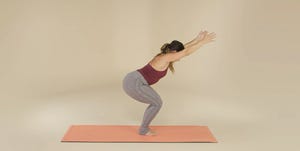
Okay, so by now you’ve probably heard of, and possibly even tried, HIIT workouts—you know those quickie 10- or 20-minute workouts that burn major cals.
But if high-intensity burpees and jump squats aren’t your thing (or make your knees scream), there’s another workout you should try: low-intensity steady-state cardio, a.k.a LISS cardio.
What is LISS Cardio, exactly?
Low-intensity steady-state cardio is just as the name describes—cardio training at a low intensity, for 45 minutes to an hour. It’s a training strategy that’s designed to keep your heart rate at a fast, but sustainable rate. “That’s usually around 60 to 70 percent of your max heart rate, also known as your fat-burning zone,” says Kelvin Gary, NASM-certified personal trainer, founder and owner of Body Space Fitness in New York City.
LISS: Low Intensity Steady State
Unless you’re wearing a heart-rate tracker, this may be challenging to pinpoint. But you should feel like you’re putting in more effort than a normal walking pace, but not as much as a full-blown run.
LISS can come in many forms, including swimming, taking an incline walk on the treadmill, using an elliptical, or going for a long bike ride. “It can even be a lengthy hike, light jog, or bout of yard work on a brisk day,” says Gary.
The key with LISS cardio is that you can almost put your body on “autopilot,” repeating the same thing over and over—whether it’s one foot in front of the other on a run, or pedaling your legs—with extremely low risk of injury.
But…is it worth trying?
While exercise itself has all kinds of benefits, the most notable physical benefit from LISS cardio is increased cardiovascular endurance—a.k.a. you’ll be able to work out longer, without getting winded or tired, says Don Saladino, NASM-certified personal trainer, owner of Drive 495 in New York City. And, just like its high-intensity cousin, LISS burns fat, too—the workouts themselves are just a bit longer, so they’re less efficient than HIIT.



“It also speeds up recovery because it helps to remove the body’s waste,” says Saladino. “Lactic acid builds up inside the body daily, but low-intensity steady state cardio helps put fresh oxygen back into the body, and gets the blood to circulate.”
Plus, it’s great for anyone who’s new to exercise, or for anyone who’s body is in a world of pain after HIIT. “LISS cardio is the best and easiest way to get moving while keeping stress levels for the body low,” says Gary.
Okay, so should I add it to my routine?
Both Saladino and Gary recommend adding LISS one to two times per week. And try balancing it with more high-intensity workouts, as well as some form of strength training, suggests Gary.
Consider LISS as a great option for lower-impact cross-training, or for an active recovery day. “I work with people who turn to exercise to deal with stress,” explains Gary. “I have to break the news that too many high-intensity workouts over time can stress the body too much and hinder progress.” So, in addition to complete rest days, Gary recommends LISS cardio, since the workout is less taxing on the body.
Source: Read Full Article
